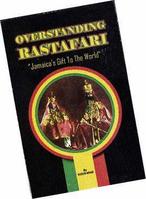
Title: Overstanding Rastafari - Jamaica's Gift to the World
Author: Yasus Afari
Publisher: SENYA-CUM
Reviewer: Paul H. Williams
Overstanding Rastafari - Jamaica's Gift to the World is Yasus Afari's gift to those who are interested in Rastafari's heritage, and to those who are not. It is 329 pages of history, interesting information, analysis, reflection, commentary, and of course, philosophy. It could have well been a textbook.
But, don't expect it to be a scholarly work, because it is not; and it does not pretend to be. Afari simply says it as it is, for you, the reader, to understand - rather, 'overstand' - the evolution and nature of a faith that has it seeds sown in Ethiopia, roots firmly grounded right here in Jamaica, and branches extending all over the world.
In 21 chapters and a glossary, Afari writes about the genesis and origins of Rastafari, early Rasta pioneers, values and ethics, concepts and beliefs, worship, rituals, language and music, food and nutrition, Rastafari and politics, Niah Binghi, the socio-economics of Rastafari, Christianity and Rastafari, and the way forward.
Learn the symbols of Rastafari in Chapter 7, and hear the story of Haile Selassie's visit to Jamaica in 1966, in Chapter 13. On pages 52-55 are lyrics of Rastafarian chants, including By the Rivers of Babylon and Rally Round the Red, Gold, Black and Green. And if you want to know the meanings of the red, gold, black and green, you will find them on pages 96 and 97. 'How the dreadlocks came about' is on page 192 - quite interesting.
Yet, more interesting is Chapter 3 - Who is Rastafari. Afari says, "His Imperial Majesty, Emperor Haile Selassie I of Ethiopia was born on Saturday, July 23, 1892, and was given the name Lidj Tafari Makonnen ('Lidj' means male child), 'Tafari' means Creator, Makonnen is his father's name. His father is the Royal RAS Makonnen, cousin to the Emperor Menelik II. And his mother is Weyzaro Yeshimabet ... (In 1916), he was elevated to the title of RAS and became RAS Tafari: Regent and Heir to the Ethiopian Throne."
RAS Tafari eventually took on a cult following, with Jamaica becoming one of the bedrocks of Rastafarianism. At the beginning of the 1930s, according to Afari, "The streets of Jamaica (Kingston and St Catherine in particular) were energised by the inspired preachings and teachings of the Honourable Leonard Howell, one of the earliest Rastafarian pioneers."
Not readily embraced
However, Rastas were not readily embraced. In fact, they were marked for death, as vividly described by Afari: "They were individually branded as 'black heart man', and children were instructed and brainwashed to fear them and hide from them, so as not to become victims of their alleged cannibalistic behaviour. Rastafarians were relentlessly stoned, ridiculed, viciously beaten, trimmed, even killed and otherwise vilified by the civilian population. They had to operate underground, out of public scrutiny by travelling in trenches, gullies and bushes ... "
The original Rasta camps were regularly raided and dislocated by the police "as the governing class and conservative sectors of the Jamaican society became alarmed by the grossly misunderstood Rastafarians".
This resentment culminated in bloodshed in 1963, in Coral Gardens, St James, when some Rastafarians and other civilians were involved in disturbances. The Jamaica Defence Force was called in and "consequently, many Rastafarians were killed, beaten, intimidated brutally, trimmed, ridiculed, harassed and arrested". Afari says: 'This unfortunate and brutal episode, represented the most horrific experience of the Rastafarians in Jamaica.'
Rastafarianism has come a long way since then, and has made its mark in many facets of Jamaican society, especially in entertainment and religion. It has pervaded the globe, easily recognised by its symbols. From the bushes and gullies of Jamaica, Rastas are on the world stages, waving the black, green, red and gold.
However, in some quarters, Rastafarians are still regarded with a great deal of mistrust and suspicion, still misunderstood. That might just be Afari's reason for writing this book. For, in it, he comprehensively explores the origin, development, and nature of the faith and the people, perhaps with the hope that doubters and sceptics would 'overstand' Rastafari. Yet, the only thing that is significantly bad about Overstanding Rastafari - Jamaica's Gift to the World is that the original manuscript needed a good proofreader.

